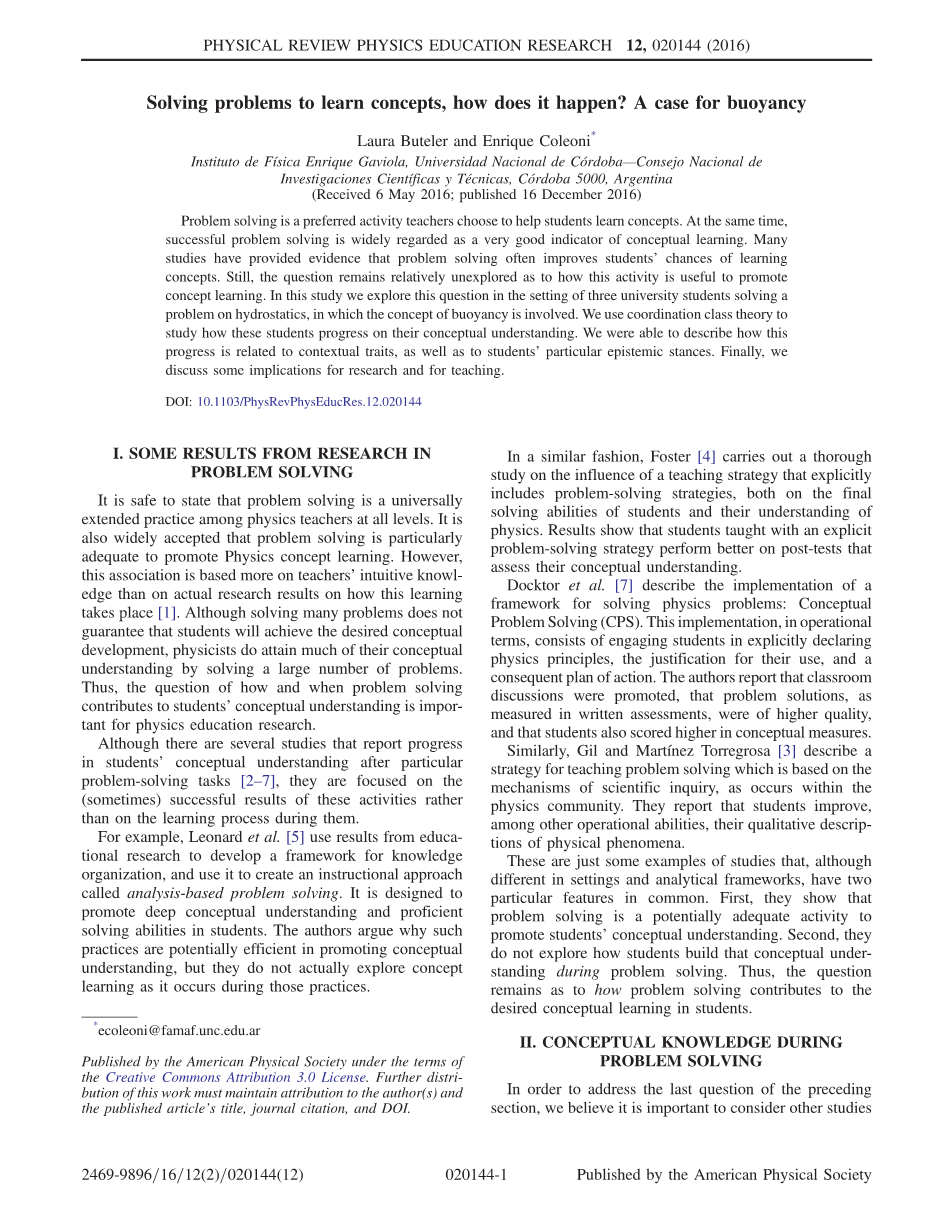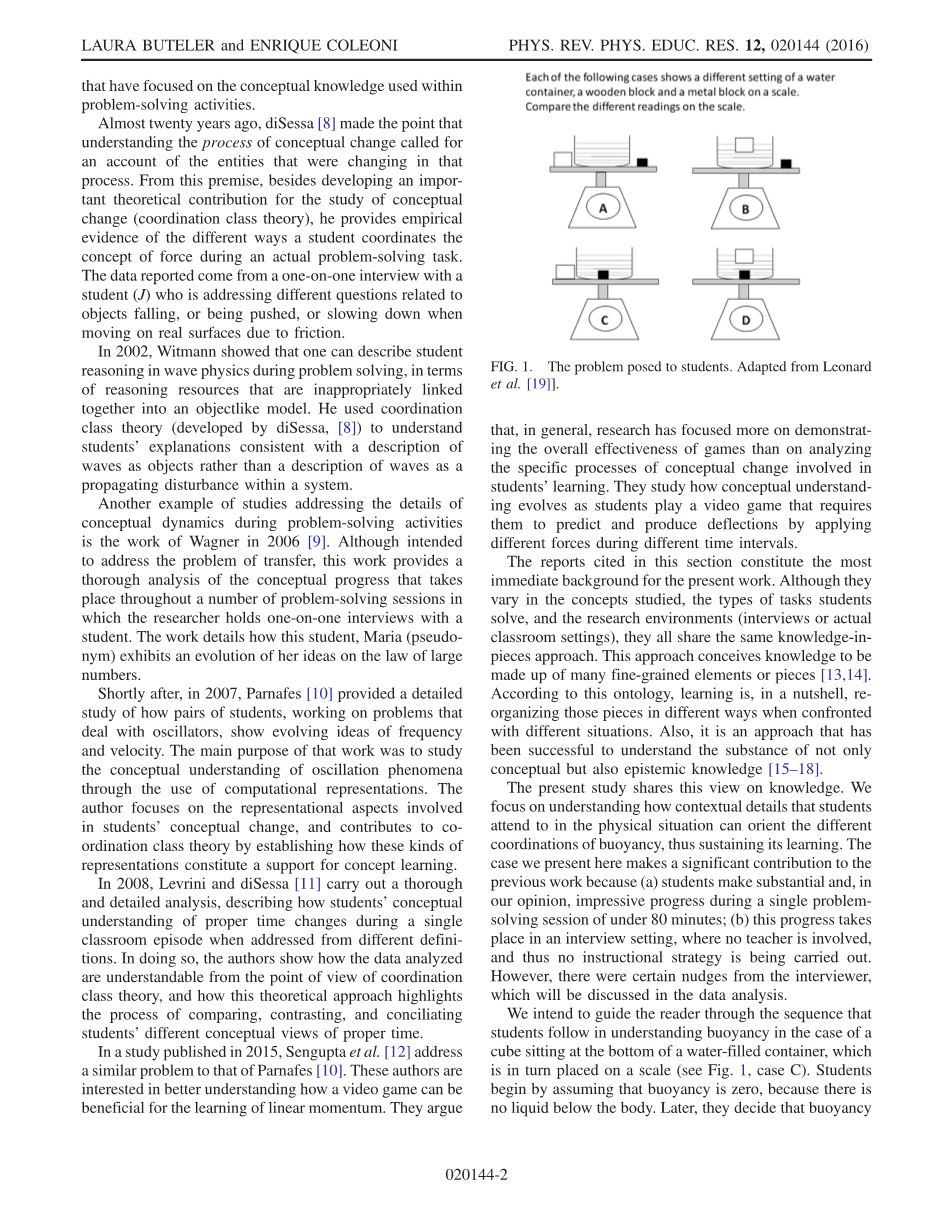外文翻译资料
2022-12-29 11:47:05
本科毕业设计(论文)
外文翻译
Solving problems to learn concepts, how does it happen? A case for buoyancy
作者: Laura Buteler and Enrique Coleoni
国籍: Argentina
出处: PHYSICAL REVIEW PHYSICS EDUCATION RESEARCH 12, 020144 (2016)
原文正文:
VII. RESULTS AND ANALYSIS
Two ideas arose during the first interview that went unquestioned by the students: the cube at the bottom of the water-filled container receives no buoyant force; and all four scales show the same reading. In this second interview we revisited the same situation and asked them to consider it once again. When they tried to compare cases A and C (see Fig. 1), they stopped to understand what the scale reads in case C. This doubt generated an extended discussion (80 minutes) during which we were able to observe important changes in their conceptualization of buoyancy. Although these changes are observed throughout the complete interview; we will show four snippets (Si) that are representative of them in subsections A–D. They are continuous sequences of studentsrsquo; speech.
A. There is no buoyant force at all
S1 [3:10 min]: “Assuming there is no liquid between the small cube and the bottom of the container”
(1) A: and we said likehellip; buoyancy does not do anything to it because it is completely touching the bottom side of the beaker
(2) J: therersquo;s no liquid under it
(3) A: so the scale reading is the normal force that the bottom does on it, and its magnitude is the same as its weight. (J agrees)
(4) J: assuming there is no liquid between the cube and the bottom
(5) A: that “ideal” stuff they always tell us that happen! (laughter)
(6) Int.: what if I replace that little cube for a little ball of the same material, and the same volume, just change the shapehellip; in that case, is your answer the same as for the cube?
(7) J: well, in that case it has water underneath.
(8) Int.: what does it mean “it has water underneath”?
(9) J: because here, with the cube, Irsquo;m assuming that it is completely in contact with the base of the container, then there is no water between the cube and the container.
FIG. 3. Schematic diagrams of the three projections reported in S1. (a) No buoyancy on sunk cube, (b) nonzero buoyancy for sunk sphere, and (c) nonzero buoyancy for either sunk body.
(10) Int.: ok, so, you mean, the base of the cube is dry?
(11) J: (smiles in a gesture that indicates that appreciation was an exaggeration) hellip; yeahhellip;
(12) A: I meanhellip; ideallyhellip; (ironic tone)
(13) M: I donrsquo;t think shape has nothing to do with it, lsquo;cause we never cared about shape to compute the magnitude of buoyancy.
(14) A: yeahhellip; I mean
(15) J: sure, buoyancy doesnrsquo;t depend on shape, just volume, so in this case (cube at the bottom) there should be a buoyant forcehellip;
(16) A: (confused)hellip; so it would be the samehellip;. the same as herehellip;. (comparing the case of the ball and of the cube)
(17) J: careful, lsquo;causehellip; remember when we saw why there is buoyancy, it was because the volume of water displaced was held by the water underneathhellip; so that generates buoyancyhellip; so it does matter if there is water underneath or not.
Three distinct projections can be identified in this snippet. A very particular read-out strategy seems to have triggered the first of these projections: there is no liquid underneath the metal cube and, thus, they infer that buoyancy is zero (turns 1, 2, 4, and 9). On the other hand, another read-out strategy triggers the second projection: there is liquid underneath the ball, and therefore, there is a nonzero buoyant force (turn 7). A third projection momentarily puts the previous two on hold. It is triggered by a read-out that indicates that both bodies (cube and sphere) displace liquid, regardless of their shape. Since the value of the buoyant force does not depend on shape, but only on displaced volume, then both bodies are affected by the same buoyant force. (turns 13, 14, 15, 16).
In turn 17, J is explicit in his attempt to articulate projections 1 (buoyancy is zero on the cube) and 2 (buoyancy is nonzero for the sphere). He understands, at the same time, that buoyancy is related to the volume of liquid displaced, but there is also an extra condition for this to be true: there must be liquid underneath the body.
Figure 3 shows a scheme of these projections. As shown in Fig. 3(a), the read-out there is no water under the cube, is activated together with another one: the surfaces are totally smooth (turns 1, 9). Both read-outs are consistent with the problem figure, in which the cubersquo;s bottom face is in complete contact with the bottom of the container. However, we also believe that the activation of these read-outs is linked to a particular epistemic stance, or idea, that is consistent with a strategy that students consider licit to solve physics problems. This can be defined as follows: “to solve physics problems it is ok to simplify aspects of the situation as needed.” This idea is epistemic because it represents a stance on knowledge construction (particularly during problem solving). This piece of epistemic knowledge (turns 4, 5, 11, 12) enables students to read-out particular traits of the contacting surfaces: the surfaces are completely smooth and there is no water under the cube. These read-outs are not only triggered by the geometrical depiction of the surfaces
剩余内容已隐藏,支付完成后下载完整资料


英语原文共 12 页,剩余内容已隐藏,支付完成后下载完整资料
资料编号:[276490],资料为PDF文档或Word文档,PDF文档可免费转换为Word




